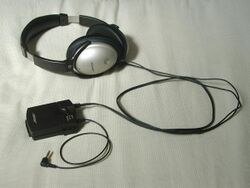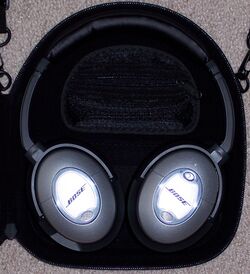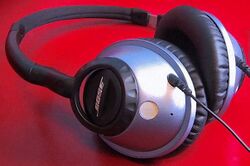Engineering:Discontinued Bose headphones
This is a list of headphone products sold by the Bose Corporation that have been discontinued.
Previous noise reducing headphones
Bose QuietComfort Headphones
The Bose QuietComfort Headphones (also now known as the QC1) were the first consumer level headphones released by the company in 2000.[1]
The Bose QuietComfort Headphones came with
- an external noise controlling mechanism, which enables the control of both volume and background noise cancellation
- Bose's patented Acoustic Noise Cancellation Technology
- Active Equalization requiring power to improve the sound quality and counteract the effects of active noise cancelling
- A carry case
Bose QuietComfort 2 Headphones
To address some of the concerns with the QuietComfort Headphones, in 2003, Bose released their successor, the Bose QuietComfort 2 Headphones (also now known as the QC2). Like their predecessor, the QuietComfort 2 Headphones retailed at a suggested price of 299 USD in the US and approximately 480 USD in Europe (£275).
Changes from the original QuietComfort Headphones include:
- TriPort headphone technology giving improved bass and treble
- Lower noise floor
- Improved acoustics
- Removal of the battery box
- On-off switch on the right earcup
- Collapsible one-wire attenuator to control the noise cancellation level (from two levels)
- Use of only one AAA battery inside the right earcup, instead of two AA batteries in the former battery box
- Foldable form-factor
- Smaller carrying case
- Single cord that can be detached if the user doesn't want to listen to music
- Champagne coloured cups (rather than the matte silver of the subsequent second edition)
There is a trade-in program for previous owners wishing to upgrade to the QuietComfort headphones.
- Connector: 3.5 mm (1/8 inch) stereo mini plug, ¼ inch adapter and two prong airline adaptor
- Cord length: 6 feet (11 feet with included 5-foot extension cable)
- Headphone dimensions: 7.75"h x 6.5"w x 1.63"d
- Carry case dimensions: 8.25"h x 7.5"w x 2"d
- Weight: 6.9 ounces, with cables included
- Frequency Response: 20 Hz to 18 kHz
- Operating temperature: 0°C to +40°C
- Storage temperature: −30°C to +70°C
- Battery: One AAA alkaline battery
- Battery life: 30 to 40 hours of use
- Cup rotation: vertical axis ±20°; horizontal axis +45° / −5°; storage position 90°
- Warranty: 1 year
- Price: $ 299 USD; £ 275.00 GBP; € 399.00
Bose QuietComfort 2 Headphones "Second Edition"
The Bose QuietComfort 2 Second Edition was introduced in August 2005. The earcup color was changed to silver, "acoustic equalization" was added, and the earcups incorporated magnetic pads.
The QC2 is powered by a single AAA battery inside the right earcup with a built-in attenuator. The cord can be detached at the user's discretion for stand-alone noise cancellation.
JAL provides Bose QuietComfort 2 Headphones for use by passengers in premium flight classes on some long-haul flights.[3]
A cellphone adapter was made available to users for the second edition and QC3 headphones.[4][5]
Previous TriPort headphones
Bose Around-Ear (AE) Headphones
Introduced in 2002[6] and originally called the 'TriPort headphones', they were renamed the 'Bose Around-Ear (AE) Headphones' in October 2006. The Bose Around-Ear headphones don't have active noise cancellation (as opposed to the QuietComfort 2 headphones). For a short time, the Bose Around-Ear headphones were also sold with a Bose-badged CD player as a part of the company's 'TriPort CD Music System'.
A The New York Times reviewer commented that "the research effort paid off: the [Bose Around-Ear Headphone] has very full sound and works equally well with all types of music," but judged a competitor's headset, priced at a lower price of the Around-Ear's, to be "just as comfortable and just as light, and the sound it produced was just as full and clear."[7] The competitive product was a Sennheiser HD 497, which "like the Bose [Around-Ear Headphones]... deliberately leaks some frequencies to balance the sound." However, the reviewer notes that the HD 497 are bigger than the AE.
A few months after the release of the Apple iPhone in 2007, Bose redesigned the AE's headphone plug to make it iPhone compatible
On-Ear headphones
The Bose On-Ear headphones were introduced on October 12, 2006. These are similar to the Bose QuietComfort 3 Headphones, but without active noise cancellation. The cord is detachable; both 43 and 16-inch cords are available.[8] Shortly after the release of the iPhone in 2007 Bose redesigned the OE's headphone plug on the detachable cords to make it iPhone compatible. In 2008, the Red Dot Award for product design was awarded to Bose On-Ear Headphones.[9]
Bose In-Ear (IE) Headphones
The Bose In-Ear headphones were introduced on October 12, 2006 as the company's first earbud product. Three eartips of different sizes are included. Bose claims that the IE's silicone tips are shaped to fit the ear's natural curves more closely.[10]
The TriPort airducts in this product consist of two air ducts in the large grille, and one "stand-alone" air duct on top of each earbud.[10]
After customer complaints stating that the "silicone ear tips become detached under certain conditions" and that the "stability of the headphones during certain activities, such as exercise, could be improved", Bose set up a website to send redesigned ear tips and a new clip and the lanyard for free.[11][12][13]
IE v2
On March 15, 2007 Bose redesigned the headphones which fixed many of the issues with the silicone ear tip stability. The cord for the redesigned headphones is now black and white to signify the change.[13][14]
IE v3
Shortly after the release of the iPhone, on October 11, 2007, Bose redesigned the IE's for a 3rd time. They made the headphone plug iPhone-compatible and removed the circuit board from the headphone plug and moved it up the cord. Bose also included a shirt clip and a lanyard on this revision as well for stability during active use.
Sometime before Christmas of 2008 Bose added a hologram to the back of the circuit board, and other distinctive features, to aid in the identification of counterfeits.[15][16][17][18] A new plastic carton has a window to show the hologram on the back of the circuit board of the In-Ear Headphones for easy detection of genuine Bose products.
Previous Mobile Headphones
Bose Mobile In-Ear (MIE) Headphones
On July 16, 2009 Bose released a mobile version of their In-Ear headsets. It features an in-line microphone and control to navigate music remotely on select cellphones/music players, and answer/end button for calls and includes 2.5mm cellphone adapters.
Bluetooth Headset
On November 1, 2010, Bose released its first wireless Bluetooth headset.[19] It has technology that will allow a user to move between a quiet and loud environment, without having to change volume controls. The headset has a special design that allows its built-in mic to selectively sense a user’s voice, and acoustically reject the background sounds that interfere with it — so that the caller is heard more, and distractions are heard less. The headset also comes with Bose StayHear tips for a comfy and secure fit without the need for an ear hook. The headset also has a sliding on/off switch for answering calls or turning the device on and off. Finally, the Bose Bluetooth headset comes with a protective case and 3 ear-tips.[20]
Previous Aviation headsets
Bose Aviation Headset Series I
The Bose Series I Aviation Headset is introduced in 1989 as the first commercially available Active Noise Cancellation headset specially designed for pilots, also used by the United States Air Force .
Initially, the Bose Aviation Family were not to be sold to civilian markets, since this is considered to Bose as a military application.
Although the Aviation Headset used active noise reduction technology, the headphones relied more upon the clamping force of the headphones and other passive noise reducing technology. Also Bose used a 9-pin connection instead of the commonly used 6-pin comm. connection.
The Aviation Headset includes:
- Active equalization - Clean full sound quality that enhances intelligibility of radio and intercom audio and enables natural sounding music reproduction
- Acoustic noise cancellation - reduces noise over the full range of the human hearing
- Integrated boom detaches, to be worn on either the right or left earcup.
- Portable carry case for headphone and accessories
There is an installed control module that will allow the headphones to be permanently installed in the aircraft thus eliminating the need for battery power.
Series I aviation headsets are distinguished by the clear windows on the earcups or by noting that the on/off switch and volume control are located on the separate control module.
- Weight: 18 ounces
- Battery: NiCa battery
- Battery life: 8 hours of use
- Shielded: No
- Warranty: 2 years
- Price: $995 USD
Bose Aviation Headset Series II
The Bose Series II Aviation Headset is introduced in 1995 with improvements for the aviation industry, earning the Aircraft Owners and Pilots Association’s (AOPA) “Product of the Year” award.
Reducing noise is important for intelligibility. U.S. Air Force tests, achieved intelligibility scores of 95% at 115 dB—compared to 80% for conventional headsets.[21]
Changes from Series I to II are
- Volume was put on the headbands.
- On/off buttons were put on the headband.
- Individual left and right volume controls
- Relied less on passive noise reduction than its predecessor.
- Now using the more commonly found 6-pin comm connection
There is an installed control module that will allow the headphones to be permanently installed in the aircraft thus eliminating the need for battery power.
Series II aviation headsets are distinguished by the dual volume controls and on/off switch located on the headset itself.
- Weight: 22 ounces
- Battery: Six AA alkaline batteries
- Battery life: 12 – 16 hours of use
- Shielded: No
- Warranty: 2 years
- Price: $995.00 USD
Bose Aviation Headset X "Magellan"
The Bose Aviation Headset X (Pronounced ten not the letter X), released in 1998, designed for pilots also used by the United States Air Force .
The TriPort speakers were introduced with the release of the Aviation X headsets. With their introduction not only was the sound quality improved over its predecessor, but due to its design the weight of the headphones was reduced. The TriPort speakers leave more space inside the ear cups for passive attenuation and allows for reduced headband force. This is mainly since the porting technology diminished the need for more passive noise reducing techniques such as clamping force and extra padding. But these headphones do have more passive noise reduction than the QC2’s giving them better noise reducing abilities with the same active noise reduction technology.
Reducing noise is important for intelligibility. U.S. Air Force tests on their previous Bose Acoustic Noise Cancelling headsets achieved intelligibility scores of 95% at 115 dB—compared to 80% for conventional headsets. The Bose Aviation Headset X offers even more noise reduction.[21]
The Improvements over the Series II include
- TriPort speaker technology giving a lower bass, a lighter weight, and significantly reduced clamping force.
- Redesigned boom microphone - for increased loudness and improved pivot design for more accurate positioning of the boom near the pilot's mouth
- Low battery life indicator - flashes red when less than 5 hours of battery life remain.
- Improved immunity from electro-magnetic interference (EMI) - reduces noise prevalent in larger business jets and military applications.
- Ability to use with a helicopter with an additional adaptor.[22]
There is an installed control module that will allow the headphones to be permanently installed in the aircraft thus eliminating the need for battery power.
The Bose Aviation Headset X costs $995. Keep in mind that the Bose Aviation X was designed to be more of a military and/or aviational application and cannot be used to create and/or listen to music, although it's possible to obtain the Bose Aviation X through civilian channels, mainly through Bose-owned outlets.
Aviation Headset X was voted #1 by Professional Pilot Magazine’s headset preference survey 5 years in a Row from 2000 to 2005 (Headset Preference Survey, 12/05)
- Sensitivity/Sound pressure level: 90 dB/mW
- Impedance: 162 ohms Monaural; 320 ohms Stereo
- Battery: One 9V battery
- Battery life: 20 hours of use
- Dimensions: (4.5 to 5.7)"h (4.8 to 6.3)"w
- Weight: 12 ounces or 340 grams
- Frequency response: 15 Hz to 15 kHz
- Shielded: Yes
- Warranty: 2 years
- Price: $995 USD
Bose Aviation Headset X "Explorer"
The original Bose Aviation Headset X ("ten")[24] was released in 1998. This was Bose's first product using "triport" technology, and according to Bose was lighter in weight, used less headband force, had better sound, and better noise reduction than Bose's previous aviation headset.
Aviation Headset X was voted #1 by Professional Pilot magazine's headset preference survey five years in a row from 2000 to 2005.[25]
The July 2003 "Explorer" model added improvements in the "down cable" assembly (including the boom microphone and battery pack).[26]
Bose offers an accessory for this model which allows the headphone to be permanently installed in the aircraft and eliminates the need for battery power, and offers trade-up programs for earlier models.[22]
Awards
- 2002 Red Dot award for product design on the QuietComfort 1[27]
- 2004 Red Dot award for product design on the QuietComfort 2[28]
Criticisms
Consumer reactions to different headphones and earbuds do vary, since audio products tend to perform differently for a wide variety of reasons. The performance of headphones depends greatly on a variety of factors, including musical genre, the recording medium (whether vinyl, CD, DVD, compressed audio file, etc.) and playback equipment.
QuietComfort Headphones (QC1)
- Frequent cracking of the headband and earcups. Users had issues with the headband and earcup construction.
- Excessive "hissing". Users claimed that there was significant audible hissing when the noise cancellation capability was turned on.
- Lack of collapsibility. The QuietComfort Headphones were not collapsible.
- "Two-corded syndrome". Unlike most modern full-sized noise-cancelling headphones, the Bose QuietComfort Headphones used two cords (one on each earcup). Because the cords were very long, it was very easy to tangle items in or trip over the cord, causing damage to either the headband or the earcup.
- Battery-powered noise attenuation pack. The headphones required an external noise-cancellation control device, considered unwieldy by many users.
- Battery usage. This product required 2 AAA batteries.
- No detachable cable. The Bose QuietComfort headphones were permanently attached to the stereo cord. If a user wished to use the noise cancellation feature without listening to music, there would be a stereo jack dangling from his or her head.
QuietComfort 2 Headphones (QC2)
- Noise cancellation had to be active for any input/output to be present. When the battery died, so did the sound.
- Dependent noise cancellation. The headphones cannot be used with the noise cancellation turned off.
- Vulnerability to electrostatic noise. The QuietComfort 2 Headphones are prone to radio frequency interference arising from other radio-emitting devices operating in the immediate vicinity.
- Durability. Users complained about the use of significant amounts of plastic in the headphones' construction.
References
- ↑ "Archived copy". Archived from the original on 2007-11-10. https://web.archive.org/web/20071110234028/http://www.bose.com/controller?event=VIEW_STATIC_PAGE_EVENT&url=%2Flearning%2Fescape_the_noise.jsp&ck=0. Retrieved 2008-01-31.
- ↑ "Archived copy". Archived from the original on 2006-03-27. https://web.archive.org/web/20060327095100/http://www.bose.com.au/site/images/store/groups/pg_00032-FAQS.pdf. Retrieved 2006-06-13.
- ↑ "JAL International Flights - In-flight Entertainment (First Class)". Japan Airlines website. http://www.jal.co.jp/en/inflight/inter/first/f_enter/. Retrieved 2008-02-01.
- ↑ "Archived copy". Archived from the original on 2008-05-09. https://web.archive.org/web/20080509162933/http://www.bose.com/controller?event=VIEW_PRODUCT_PAGE_EVENT&product=qc2_headphones_accessories&linksource=productnav_txt_accessories. Retrieved 2009-08-23.
- ↑ [1] [|permanent dead link|dead link}}]
- ↑ "Can the science of acoustics reduce the roar of an airplane engine?". Bose Corporation. Archived from the original on 2012-03-04. https://web.archive.org/web/20120304001730/http://www.bose.ie/IE/en/learning-centre/noise-reduction/. Retrieved 2006-08-06.
- ↑ Austen, Ian (2002-10-31). "When Headphones Measure Up to the Music.". The New York Times. https://www.nytimes.com/2002/10/31/technology/basics-when-headphones-measure-up-to-the-music.html?pagewanted=all&src=pm. Retrieved 2010-12-25.
- ↑ "Archived copy". Archived from the original on 2010-02-25. https://web.archive.org/web/20100225134927/http://www.bose.com/controller?url=%2Fshop_online%2Fheadphones%2Faudio_headphones%2Fon_ear_headphones%2Findex.jsp#tabs. Retrieved 2010-03-01.
- ↑ "online-exhibition | Red Dot Award: Product Design". http://en.red-dot.org/2788+M5cecd7e07a0.html. Retrieved 2016-11-06.
- ↑ 10.0 10.1 "Archived copy". Archived from the original on 2010-12-21. https://web.archive.org/web/20101221194836/http://www.bose.com/controller?url=%2Fshop_online%2Fheadphones%2Faudio_headphones%2Fin_ear_headphones%2Findex.jsp. Retrieved 2010-11-10.
- ↑ "archive.org - Complimentary Silicone Tips and Stability Enhancement Kit for Bose In-Ear Headphones". Bose website. Archived from the original on 2008-03-04. https://web.archive.org/web/20080304074835/http://www.bose.com/controller?event=DTC_LINKS_TARGET_EVENT&DTCLinkID=7518&src=ENHANCE. Retrieved 2009-09-23.
- ↑ "BOSE: Customer Service Never Sounded So Sweet – Consumerist". 2007-09-23. http://consumerist.com/consumer/above-and-beyond/bose-customer-service-never-sounded-so-sweet-302730.php. Retrieved 2016-11-06.
- ↑ 13.0 13.1 Berger, Ivan (2007-03-22). "Hang on to the Beat With Earbuds That Stay Put". The New York Times. https://www.nytimes.com/2007/03/22/technology/22headphones.html. Retrieved 2008-02-01.
- ↑ Akhtar, Iyaz (2007-03-08). "Bose upgrades in-ear headphones with free accessories - CNET". http://news.cnet.com/8301-17938_105-9695493-1.html. Retrieved 2016-11-06.
- ↑ "Archived copy". Archived from the original on 2010-12-22. https://web.archive.org/web/20101222050054/http://www.bose.com/controller?url=%2Fpopup%2Fshop_online%2Fproducts%2Fpop_be_sure.jsp. Retrieved 2010-11-10.
- ↑ "fakeheadphones.com". http://fakeheadphones.com/fake-bose-ies-flooding-the-market/04/2008/. Retrieved 2016-11-06.
- ↑ "Archived copy". Archived from the original on 2010-07-16. https://web.archive.org/web/20100716004127/http://goliath.ecnext.com/coms2/gi_0199-3254465/China-city-is-haven-for.html. Retrieved 2010-11-10.
- ↑ Identifying Fake Bose headphones. YouTube. 2009-03-30. Retrieved 2009-09-23.
- ↑ "Top 10 Best Bluetooth Headphones In 2016 Reviews". 2016-10-24. http://top10bestpro.com/top-10-best-bluetooth-headphones/. Retrieved 2016-11-06.
- ↑ "Bose Bluetooth Headset Automatically Adapts to Both Quiet and Noisy Environments". http://www.chipchick.com/2010/10/bose-bluetooth-headset.html. Retrieved 2016-11-06.
- ↑ 21.0 21.1 [2]
- ↑ 22.0 22.1 "Archived copy". Archived from the original on 2006-06-23. https://web.archive.org/web/20060623125850/http://www.bose.com/controller?event=VIEW_PRODUCT_PAGE_EVENT&product=headsetx_headset_accessories#tabs. Retrieved 2006-06-13.
- ↑ "Archived copy". Archived from the original on 2006-03-12. https://web.archive.org/web/20060312142910/http://www.bose.com/pdf/customer_service/owners/og_headset_x.pdf. Retrieved 2006-03-12.
- ↑ "The Bose Aviation Headset X". AVWeb. http://www.avweb.com/news/reviews/181960-1.html. Retrieved 2008-02-01.
- ↑ "Headset Preference Survey". Professional Pilot: 82. December 2005.
- ↑ "Doug's 2003 Bose X Active Noise Reduction Headset Review". Doug's Domain: Doug Vetter ATP/CFI. Archived from the original on 2008-05-13. https://web.archive.org/web/20080513070528/http://www.dvatp.com/aviation/reviews/bose_x_2003/. Retrieved 2008-02-01.
- ↑ "online-exhibition | Red Dot Award: Product Design". http://en.red-dot.org/316+M5d7f74f3f65.html. Retrieved 2016-11-06.
- ↑ "Red Dot Design Award: product design". http://en.red-dot.org/355+M5990aa525cc.html. Retrieved 2016-11-06.






